For professionals working in pharmaceutical development, analytical chemistry, or academic research, the separatory funnel is an essential tool for efficient and precise liquid-liquid extractions.
At At-Mar Glass, we manufacture high-quality glassware tailored to the demands of advanced laboratories—engineered for consistency, chemical resistance, and reliability. Our funnels are designed and fabricated entirely in-house by seasoned glassblowers, ensuring that every product meets the exacting standards of scientists, chemists, and institutions across the country.
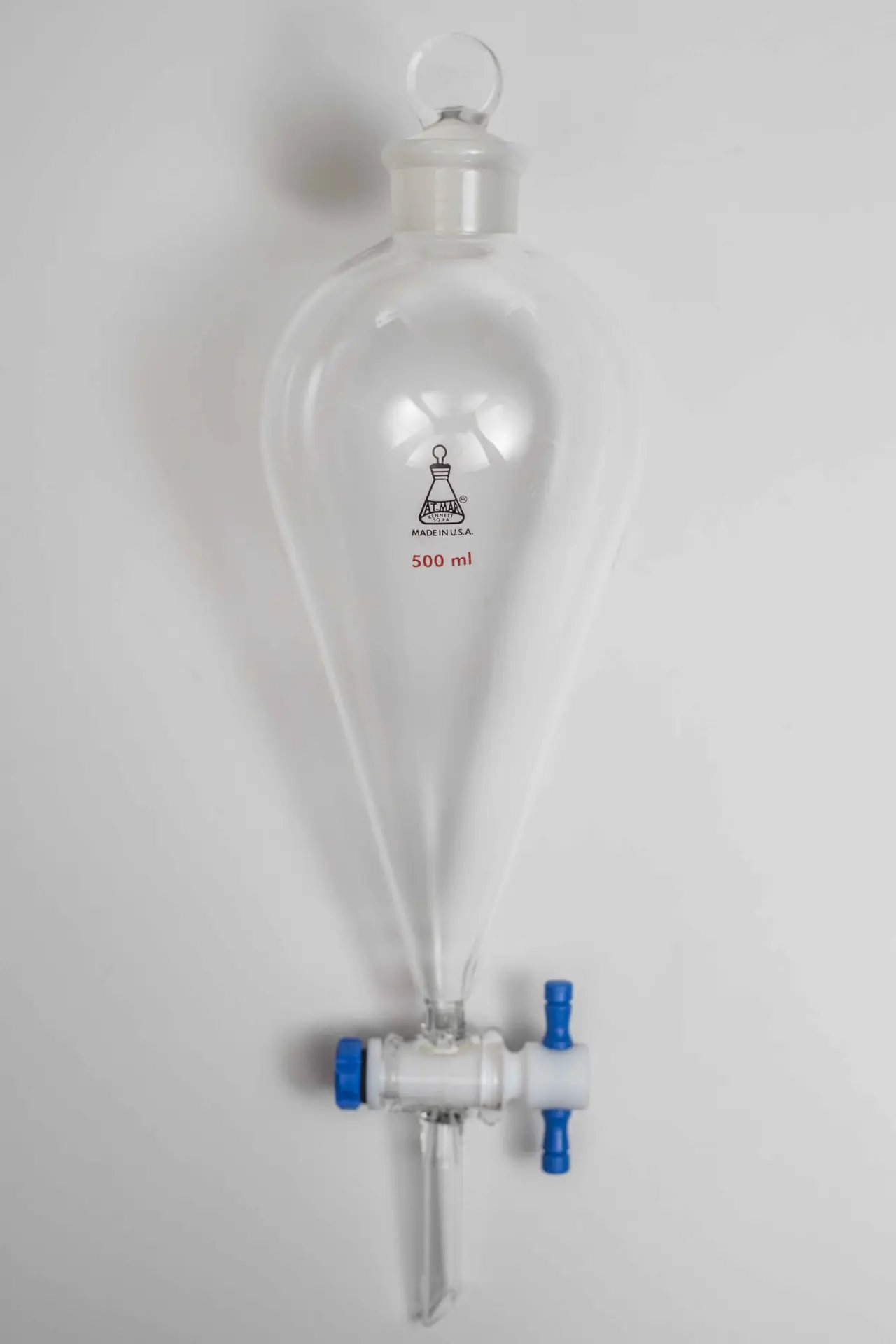
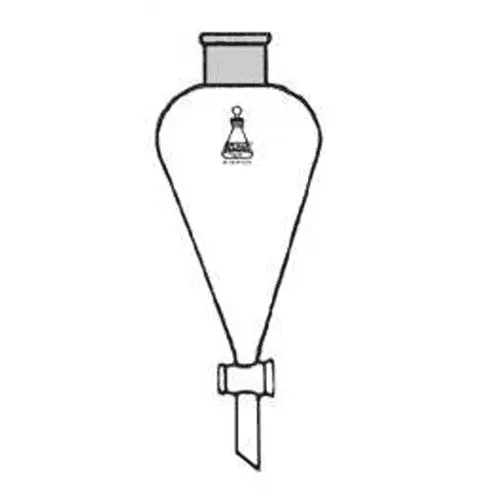







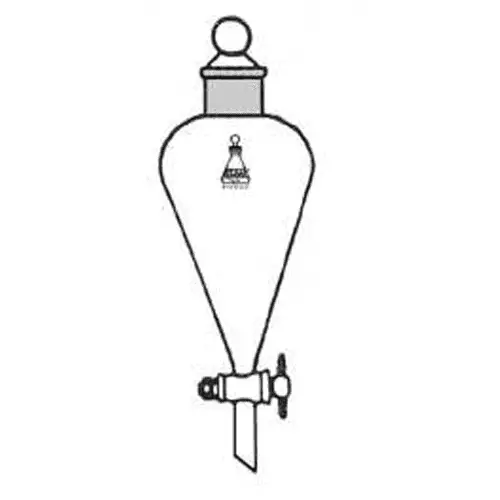




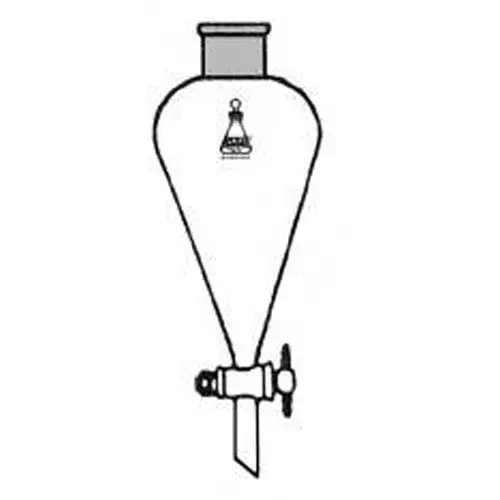


In scientific settings where precision separation is critical, the separatory funnel plays a foundational role in executing controlled extractions between immiscible liquid phases. While the concept is fundamental, its proper application and design are anything but basic—especially in high-stakes workflows like pharmaceutical compound isolation, petrochemical analysis, or environmental sample purification.
A separatory funnel is a laboratory apparatus used for separating two immiscible liquid phases, typically an organic solvent and an aqueous solution. The design typically includes a conical or pear-shaped borosilicate glass body, a ground-glass stopper, and a precision-machined stopcock at the base. In most chemistry separatory funnel setups, this design ensures optimal interface clarity and controlled drainage of the lower phase.
So, how does a separatory funnel work in practice? After thoroughly mixing the two immiscible liquids within the funnel, the mixture is allowed to settle. Due to density differences, the two layers separate naturally—often with the denser aqueous phase on the bottom and the less dense organic solvent on top.
The stopcock is then carefully opened to drain the desired phase into a receiving vessel. Mastery of this process is essential in workflows where even trace amounts of cross-contamination can compromise results.
Whether performing acid-base extractions, washing reaction mixtures, or isolating target compounds in multi-step syntheses, the what is separatory funnel question is best answered by its role: enabling clean phase separations at the bench.
In organic synthesis, separatory funnels are often employed between reaction stages to purify intermediates, remove byproducts, or recover solvents. They are also indispensable in clinical research labs where liquid-liquid partitioning is used to concentrate trace analytes from complex biological matrices.
For professionals working at the intersection of chemistry, biology, and materials science, the separatory funnel is a versatile, workhorse instrument that supports a wide array of precision-driven tasks. Its design may be simple, but its impact on workflow efficiency and compound purity is substantial—particularly in labs where reproducibility and solvent control are non-negotiable.
In pharmaceutical R&D, one of the primary uses of a separatory funnel is to isolate active pharmaceutical ingredients (APIs) from complex reaction mixtures. After a multi-step synthesis, a funnel enables selective removal of aqueous or organic phases, facilitating downstream crystallization or chromatographic purification. This is especially valuable when purity thresholds are high and regulatory compliance is critical.
Within industrial and academic research settings, separatory funnel chemistry plays a critical role in liquid-liquid extraction—whether to remove inorganic salts, extract neutral organics, or pre-treat samples for GC/MS or LC-MS analysis. Sophisticated multi-phase extractions often require controlled agitation and precise phase handling, which makes a high-quality separatory funnel indispensable.
When determining the distribution of compounds between two immiscible solvents, the separatory funnel use becomes central to partition coefficient analysis. This type of testing is common in drug design, environmental toxicology, and formulation chemistry—anywhere solubility and polarity dictate molecular behavior.
Precision in laboratory separations depends not only on technique, but on the physical integrity and quality of the apparatus itself. At At-Mar Glass, every separatory funnel is engineered with exacting detail, using materials and construction methods trusted across pharmaceutical and academic institutions alike. Understanding the core separatory funnel parts is essential to choosing a product that supports rigorous, repeatable outcomes.
The main chamber is formed from high-grade borosilicate glass, valued for its thermal resistance, low expansion coefficient, and chemical durability. This allows the funnel to maintain structural integrity even when exposed to aggressive solvents or elevated temperatures. The geometry—pear-shaped or cylindrical—enhances phase clarity and reduces emulsion retention.
At the neck, a precision-ground taper joint accommodates an interchangeable glass or Teflon stopper. This feature not only aids in tight sealing but also allows for flexibility across lab setups. The parts of separatory funnel designs we produce at At-Mar are compatible with both standard and custom joint configurations, enabling integration into existing workflows.
Perhaps the most critical functional element is the separatory funnel stopcock. We utilize high-quality PTFE (polytetrafluoroethylene) stopcocks to ensure chemical resistance, low friction, and a leak-free seal—even with viscous or corrosive solvents. The stopcock separatory funnel design we implement supports smooth control over drainage, which is vital in fractionated separations and small-volume extractions.
Unlike mass-produced alternatives, At-Mar Glass fabricates all components in-house at our Kennett Square facility. Every joint, stopper, and stopcock is carefully inspected for dimensional accuracy and functional reliability. This commitment to detail means our separatory funnel parts perform with consistency in demanding lab environments, batch after batch.
A well-executed separatory funnel setup is foundational to achieving precise, reproducible results in any high-level laboratory environment. Whether the application involves multi-solvent partitioning or sequential wash steps, proper integration into your workflow—both mechanically and procedurally—is critical for safety, efficiency, and performance. At-Mar Glass designs every component with these best practices in mind.
A typical separatory funnel set up includes a secure ring stand with a properly sized clamp to support the funnel’s neck, allowing hands-free operation during phase separation. Positioning is key: the setup must be vertically aligned and at an ergonomic height to safely open and close the stopcock without accidental spills. For sensitive procedures, drip trays or secondary containment may also be integrated.
For those familiar with advanced lab operations, knowing how to use a separatory funnel is second nature—but attention to technique still matters. Always ensure that the stopper is securely in place before shaking the funnel, and vent frequently to avoid pressure buildup. PTFE stopcocks, like those used in At-Mar funnels, allow for smooth, controlled drainage and reduce the risk of solvent leaks.
Understanding how to use separatory funnel tools in tandem with analytical techniques—like GC/MS, rotary evaporation, or preparative TLC—enhances overall workflow efficiency. For example, pre-saturating organic solvents or adjusting pH in aqueous layers can optimize recovery. The funnel’s role in solvent exchange and cleanup makes it indispensable in complex separation schemes.
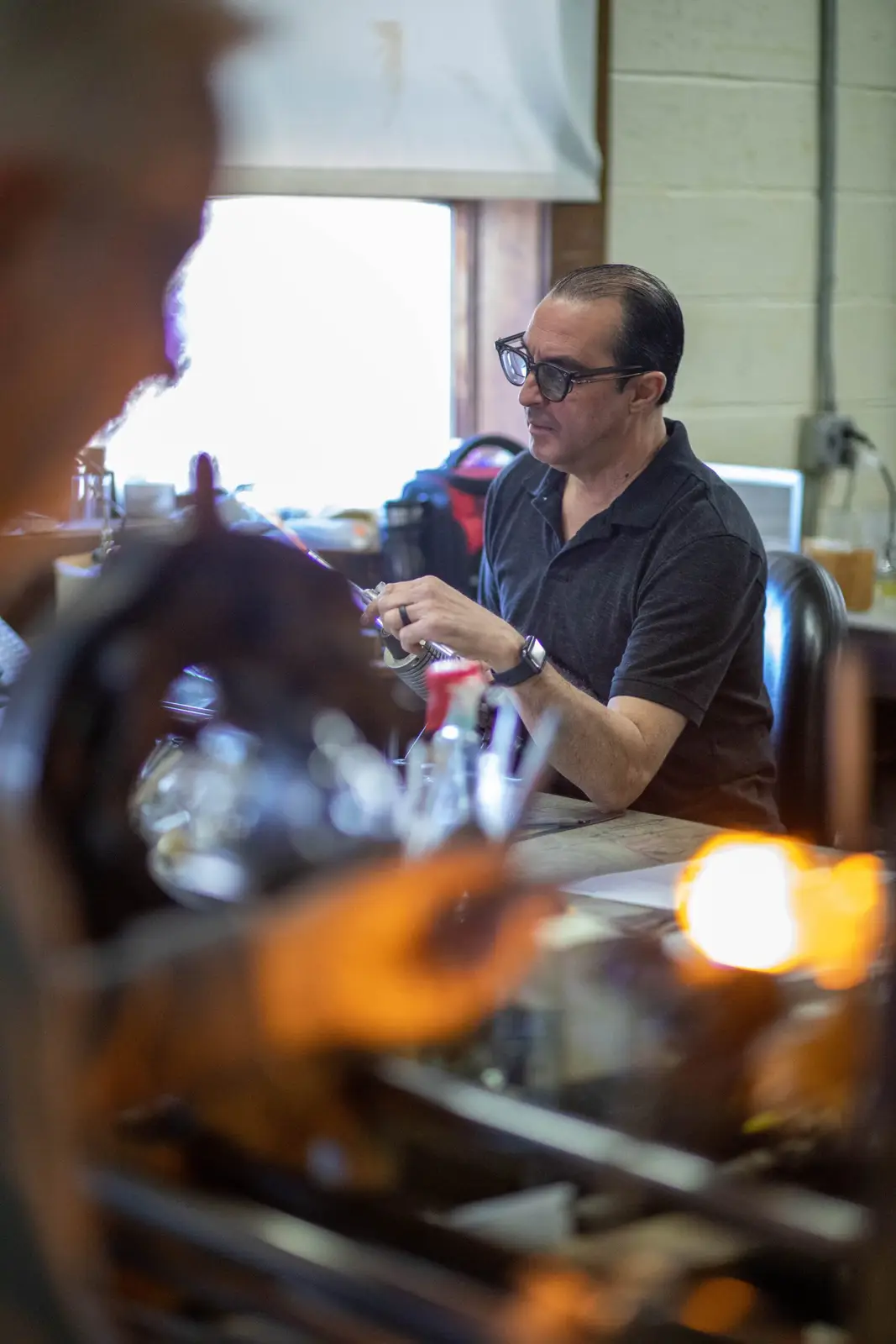
An expertly crafted separatory funnel is only as effective as the system supporting it. Selecting appropriate hardware ensures not only safety and stability, but also seamless integration into the broader lab environment. If you’re looking to identify the best support for a separatory funnel, it starts with understanding the physical demands of your workflow and the compatibility of your equipment.
A properly engineered separatory funnel stand provides stability for funnels of various volumes, minimizing movement during shaking or drainage. Adjustable stands, often used in modular lab setups, ensure compatibility with automation, jacketed glassware, or specialized collection systems. At-Mar can recommend or supply stands that complement your glassware and bench layout.
Support systems must be matched to the size and weight of the funnel, especially when working with volumes above 500 mL. The stand must hold the funnel securely even during vigorous shaking or prolonged static separation. Heavy-duty ring stands with chemically resistant coatings and high-tension clamps are recommended for industrial and high-throughput environments.
The clamp should provide firm but gentle grip at the funnel’s neck or joint—ensuring no torsion stress is applied to the glass. Stainless steel, coated metal, or PTFE-lined clamps offer the necessary balance of strength and chemical compatibility. For multi-funnel setups, dual-ring holders or scaffold-mounted configurations allow for space optimization without sacrificing access.
Accessory compatibility is another factor when deciding how to identify the best support for a separatory funnel. Drainage vessels, drip trays, custom collection flasks, or automated fraction collectors can all be configured based on lab needs. At-Mar frequently advises clients on configuring custom systems tailored to their specific analytical or preparative protocols.
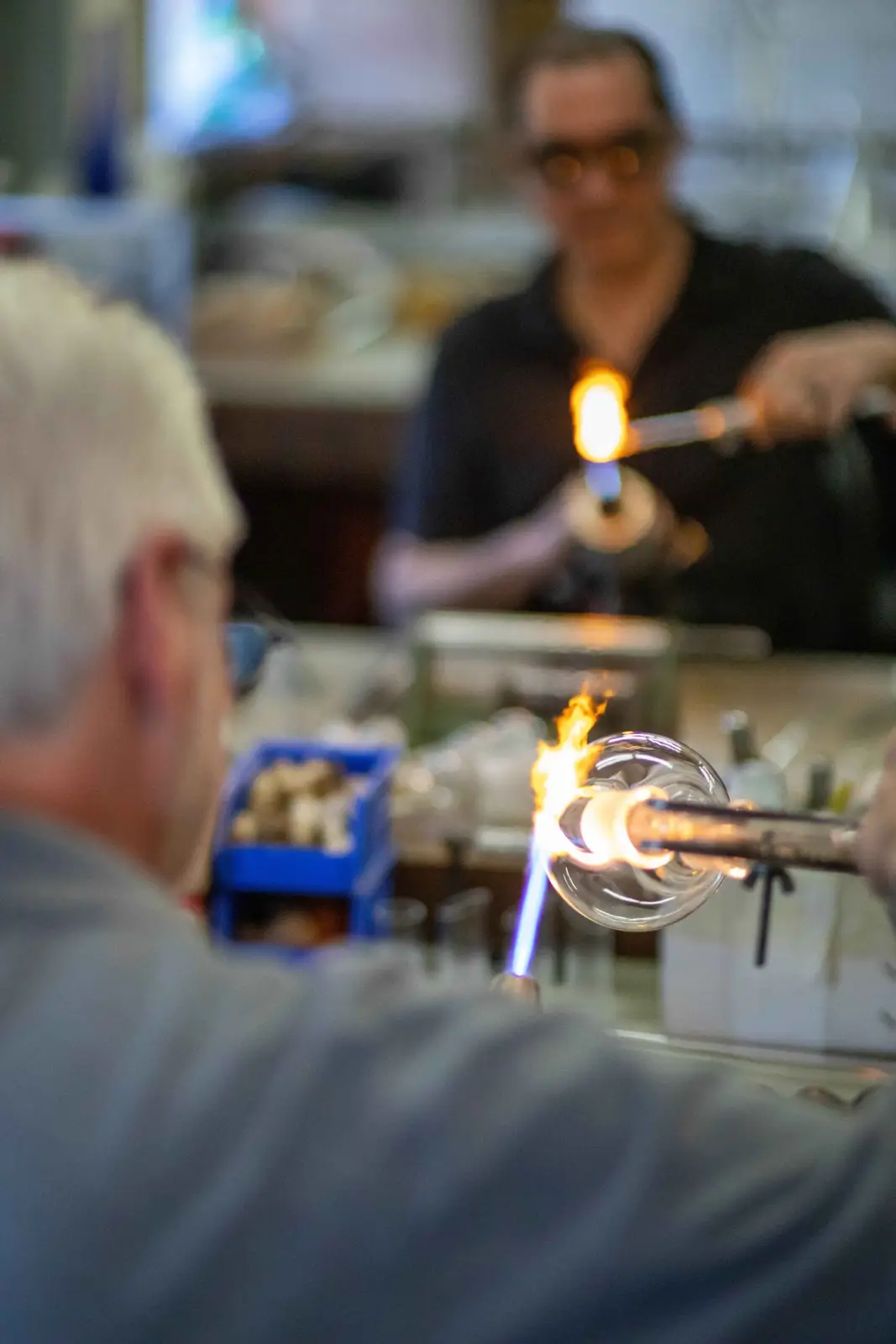
When standard glassware falls short of meeting experimental or process-specific demands, At-Mar Glass offers precision-engineered solutions built to your exact specifications. Whether your team is scaling up a reaction protocol or integrating glassware into an automated system, we specialize in translating technical requirements into functional, production-grade separatory funnels.
Our experienced team collaborates with researchers, engineers, and procurement leads to develop nonstandard separatory funnels with custom dimensions, joint types, or internal modifications. From specialized drain angles to dual-stopcock models, our clients often begin with a separatory funnel diagram or preliminary concept that we refine into fully functional labware—blown and finished in-house for complete quality control.
Whether you’re providing detailed CAD files or a conceptual sketch, we can bring your separatory funnel drawing to life. Our team ensures that all custom pieces meet the same rigorous standards as our stock glassware, with exact tolerances and materials selected for chemical compatibility, pressure resilience, and system integration. With decades of glassblowing experience and full in-house capabilities, At-Mar is built for technical collaboration at the highest level.
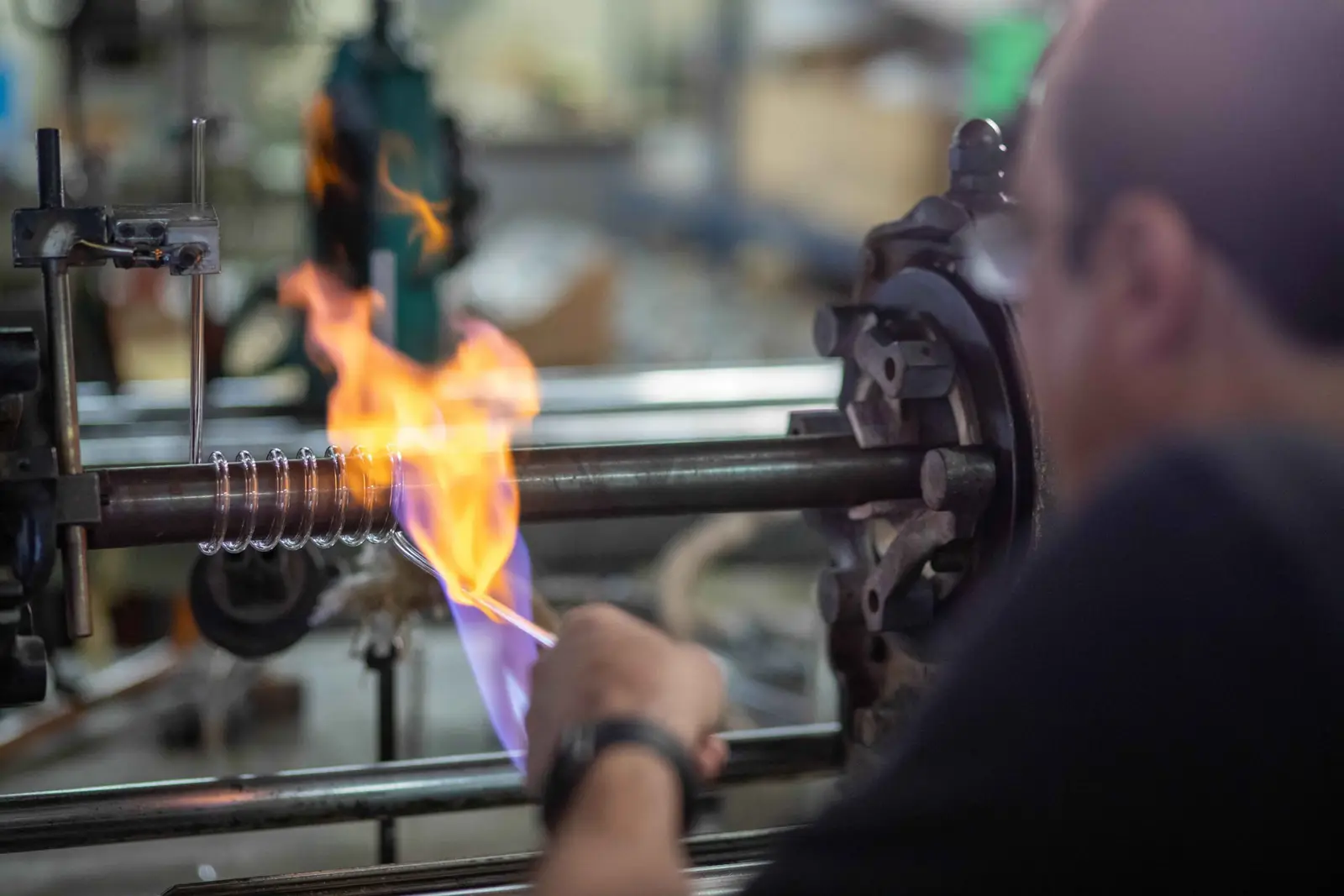
Even experienced lab professionals occasionally need clarification on best practices, material performance, or customization options when it comes to separatory funnels. Below, we’ve answered some of the most common questions we receive from pharmaceutical teams, chemists, and research institutions.
Key factors include the purity and thickness of the borosilicate glass, the precision of the taper joints, the chemical resistance of the stopcock material (typically PTFE), and the overall dimensional accuracy. Consistency in wall thickness and stress-relief during fabrication are also crucial for long-term durability.
Yes—when constructed from high-quality borosilicate glass and fitted with chemically inert components like PTFE stopcocks and stoppers. At-Mar funnels are specifically designed to handle aggressive solvents used in organic synthesis and extraction procedures.
Absolutely. Many labs require nonstandard volumes, alternative shapes, or integrated features for niche applications. At-Mar routinely fabricates custom separatory funnels based on client-provided drawings, technical specs, or project needs.
Inspection frequency depends on usage intensity and the chemicals involved. Regular checks for microfractures, stopcock wear, and joint integrity are recommended. In high-throughput or corrosive environments, periodic replacement or refurbishment may be necessary to ensure safety and performance.
Turnaround varies by complexity, but At-Mar is known for rapid response and short lead times. Standard replacements can often be fabricated and shipped within days, while more intricate custom projects are typically fulfilled in under two weeks.
Yes. We often produce funnels with features tailored for automated workstations, including custom lengths, modified joints, or reinforcement for mechanical shakers. Automation compatibility is an increasingly common request in high-throughput labs.
When precision, reliability, and responsiveness matter, At-Mar Glass stands apart. Here’s why leading pharmaceutical companies, research labs, and academic institutions trust us to supply and fabricate their separatory funnels.
Every separatory funnel we produce is fabricated entirely in-house at our Kennett Square facility. Our glassblowers have decades of experience crafting laboratory-grade glassware that meets strict dimensional and chemical resistance standards. By keeping all work in-house, we maintain full control over quality and consistency—no outsourcing, no compromises.
We understand how disruptive it can be when a piece of critical glassware breaks or needs to be replaced. That’s why At-Mar is known for some of the fastest lead times in the industry. Many repairs or replacements can be completed in just a few days, and custom work is turned around with exceptional speed—without ever cutting corners.
Whether you're working with high-throughput automation, custom joint configurations, or nonstandard extraction protocols, we can design and fabricate funnels to exacting specifications. Our team regularly partners with researchers and engineers to translate complex project requirements into functional, durable glassware.
We believe high-quality glassware should be accessible—not inflated. Our pricing is designed to reflect the value of precision craftsmanship, without the overhead or markups of larger manufacturers. The result: long-lasting separatory funnels that perform consistently under pressure, cycle after cycle.
We don’t just ship glass—we collaborate. From initial consultation to post-delivery support, our team provides the kind of personal service you won’t find in catalog-based suppliers. Whether you’re placing a bulk order or need one funnel with highly specific requirements, we’re here to help you get it exactly right.
At-Mar Glass has the skill, speed, and in-house capabilities to meet even your most specific requirements. Reach out today for a quote, a consultation, or expert input—we’re here to keep your lab running without compromise.